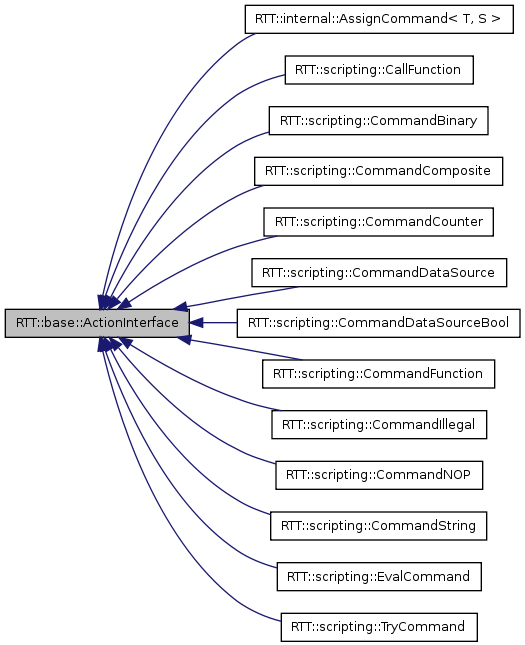Based on the software pattern 'command', this interface allows execution of action objects. More...
#include <ActionInterface.hpp>

Public Types | |
| typedef boost::shared_ptr < ActionInterface > | shared_ptr |
Public Member Functions | |
| virtual ActionInterface * | clone () const =0 |
| virtual ActionInterface * | copy (std::map< const DataSourceBase *, DataSourceBase * > &alreadyCloned) const |
| virtual bool | execute ()=0 |
| virtual void | readArguments ()=0 |
| virtual void | reset () |
| virtual bool | valid () const |
| virtual | ~ActionInterface () |
Based on the software pattern 'command', this interface allows execution of action objects.
The action may return true or false to indicate if it was accepted (true) or rejected (false).
Definition at line 71 of file ActionInterface.hpp.
| typedef boost::shared_ptr<ActionInterface> RTT::base::ActionInterface::shared_ptr |
Use this type for shared pointer storage of an ActionInterface object.
Definition at line 78 of file ActionInterface.hpp.
| RTT::ActionInterface::~ActionInterface | ( | ) | [virtual] |
Definition at line 45 of file ActionInterface.cpp.
| virtual ActionInterface* RTT::base::ActionInterface::clone | ( | ) | const [pure virtual] |
The Clone Software Pattern.
Implemented in RTT::internal::AssignCommand< T, S >, RTT::scripting::CallFunction, RTT::scripting::CommandBinary, RTT::scripting::CommandComposite, RTT::scripting::CommandCounter, RTT::scripting::CommandDataSource, RTT::scripting::CommandDataSourceBool, RTT::scripting::CommandFunction, RTT::scripting::CommandIllegal, RTT::scripting::CommandNOP, RTT::scripting::CommandString, RTT::scripting::TryCommand, and RTT::scripting::EvalCommand.
| ActionInterface * RTT::ActionInterface::copy | ( | std::map< const DataSourceBase *, DataSourceBase * > & | alreadyCloned | ) | const [virtual] |
When copying an Orocos program, we want identical internal::DataSource's to be mapped to identical DataSources, in order for the program to work correctly. This is different from the clone function, where we simply want a new Action that can replace the old one directly.
This function takes a map that maps the old internal::DataSource's onto their new replacements. This way, it is possible to check before cloning a internal::DataSource, whether it has already been copied, and if so, reuse the existing copy.
To keep old source working, the standard implementation of this function simply calls the clone function. If your ActionInterface uses a internal::DataSource, it is important that you reimplement this function correctly though.
Definition at line 58 of file ActionInterface.cpp.
| virtual bool RTT::base::ActionInterface::execute | ( | ) | [pure virtual] |
Execute the functionality of this action.
Implemented in RTT::internal::AssignCommand< T, S >, RTT::scripting::CallFunction, RTT::scripting::CommandBinary, RTT::scripting::CommandComposite, RTT::scripting::CommandCounter, RTT::scripting::CommandDataSource, RTT::scripting::CommandDataSourceBool, RTT::scripting::CommandFunction, RTT::scripting::CommandIllegal, RTT::scripting::CommandNOP, RTT::scripting::CommandString, RTT::scripting::TryCommand, and RTT::scripting::EvalCommand.
| virtual void RTT::base::ActionInterface::readArguments | ( | ) | [pure virtual] |
This is invoked some time before execute() at a time when the action may read its function arguments.
Implemented in RTT::internal::AssignCommand< T, S >, RTT::scripting::CallFunction, RTT::scripting::CommandBinary, RTT::scripting::CommandComposite, RTT::scripting::CommandCounter, RTT::scripting::CommandDataSource, RTT::scripting::CommandDataSourceBool, RTT::scripting::CommandFunction, RTT::scripting::CommandIllegal, RTT::scripting::CommandNOP, RTT::scripting::CommandString, RTT::scripting::TryCommand, and RTT::scripting::EvalCommand.
| void RTT::ActionInterface::reset | ( | void | ) | [virtual] |
Reset this action. Must be used after execute() failed.
Reimplemented in RTT::scripting::CallFunction, RTT::scripting::CommandBinary, RTT::scripting::CommandCounter, RTT::scripting::CommandDataSource, RTT::scripting::CommandDataSourceBool, RTT::scripting::TryCommand, and RTT::scripting::EvalCommand.
Definition at line 48 of file ActionInterface.cpp.
| bool RTT::ActionInterface::valid | ( | ) | const [virtual] |
Inspect if this action was executed and valid. This method may not be called before execute(). The default implementation returns always true, i.e. after execute(), it was executed. Override this method if it has more complex state semantics.
Reimplemented in RTT::scripting::CallFunction, RTT::scripting::CommandBinary, RTT::scripting::CommandComposite, and RTT::scripting::TryCommand.
Definition at line 51 of file ActionInterface.cpp.